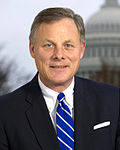Top Qs
Timeline
Chat
Perspective
2010 United States Senate election in North Carolina
From Wikipedia, the free encyclopedia
Remove ads
The 2010 United States Senate election in North Carolina was held on November 2, 2010. The filing deadline for the primaries was February 26; the primaries were held on May 4, with a Democratic primary runoff held on June 22.[1] Incumbent Republican U.S. Senator Richard Burr won re-election to a second term. Burr is the first incumbent to win re-election for this seat since Sam Ervin's last re-election in 1968.[2]
Burr was the first Republican re-elected to this seat. Burr's 54.8% also represented the highest vote share a North Carolina Republican received since the state began directly electing its senators.
This was one of the five Republican-held Senate seats up for election in a state that Barack Obama won in the 2008 presidential election.
Remove ads
Background
This Senate seat was unfavorable to incumbents over the past several decades. No person elected to this seat was re-elected since Sam Ervin in 1968. His successor, Democrat Robert Burren Morgan, was defeated for re-election in 1980, along with many other incumbents from his party. His Republican successor, John Porter East, committed suicide in 1986. East's appointed successor, Jim Broyhill, served for just four months, resigning upon his November 1986 election loss to former Democratic Governor Terry Sanford. In 1992, the seat changed hands yet again, as Sanford was defeated by wealthy GOP businessman Lauch Faircloth, who himself lost in his bid for a second term six years later by John Edwards. In 2004, no incumbent was defeated, as Edwards was running for vice president and was not allowed to be on the ballot in both races. However, that year the seat did change parties for the fifth time in a row, with Richard Burr defeating Bill Clinton's onetime Chief of Staff Erskine Bowles.
Remove ads
Republican primary
Candidates
- Eddie Burks, Asheboro City Councilman[3]
- Richard Burr, incumbent U.S. Senator
- Brad Jones, businessman[4]
- Larry Linney, former State Representative[5][6]
Polling
Results
Remove ads
Democratic primary
Summarize
Perspective
Candidates
From the North Carolina State Board of Elections:[5]
- Cal Cunningham, former State Senator[12][13]
- Susan Harris, retired accountant[14]
- Ken Lewis, attorney[15]
- Elaine Marshall, North Carolina Secretary of State and candidate in 2002[16][17]
- Marcus Williams, attorney
- Ann Worthy, former Gaston County Board of Education member
Polling
Results

Marshall
- 20–30%
- 30–40%
- 40–50%
- 50–60%
- 60–70%
Cunningham
- 20–30%
- 30–40%
- 40–50%
- 50–60%
Lewis
- 30–40%
- 40–50%
Williams
- 30–40%
* Note: Since no candidate received 40% of the vote on May 4, state law allowed a runoff (or "second primary") election if requested by the second-place finisher. Cunningham requested such a runoff.[24]

Marshall
- 50–60%
- 60–70%
- 70–80%
Cunningham
- 50–60%
- 60–70%
- 80–90%
Remove ads
General election
Summarize
Perspective
Candidates
- Michael Beitler (L), lecturer of Bryan School of Business and Economics at the University of North Carolina at Greensboro[25]
- Richard Burr (R), incumbent U.S. Senator
- Elaine Marshall (D), North Carolina Secretary of State
Campaign
Marshall was endorsed by The Charlotte Observer, The Wilmington Star-News, the Elizabeth City Daily Advance and The Southern Pines Pilot.[26] Burr was endorsed by the Greensboro News & Record[27] and the Asheville Citizen-Times.[28]
Debates
- October 11: Sponsored by the North Carolina Association of Broadcasters Education Foundation and moderated by the Carl Kasell. It was televised by UNC-TV in Raleigh.[29]
- October 14: In Raleigh[30]
- October 21: Sponsored by N.C. Association of Broadcasters and moderated by Judy Woodruff in Durham.[31]
Predictions
Polling
Fundraising
Results
Counties that flipped from Democratic to Republican
- Caswell (largest city: Yanceyville)
- Columbus (largest municipality: Whiteville)
- Yancey (largest municipality: Burnsville)
- Perquimans (largest city: Hertford)
- Camden (largest city: Camden)
- Tyrrell (largest municipality: Columbia)
- Guilford (largest city: Greensboro)
- Swain (largest municipality: Cherokee)
- Granville (largest city: Oxford)
- Hyde (largest community: Ocracoke)
- Jackson (largest town: Cullowhee)
- Wake (largest town: Raleigh)
Remove ads
See also
References
External links
Wikiwand - on
Seamless Wikipedia browsing. On steroids.
Remove ads




